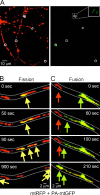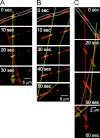Bcl-x L increases mitochondrial fission, fusion, and biomass in neurons
- PMID: 19255249
- PMCID: PMC2686401
- DOI: 10.1083/jcb.200809060
Bcl-x L increases mitochondrial fission, fusion, and biomass in neurons
Abstract
Mitochondrial fission and fusion are linked to synaptic activity in healthy neurons and are implicated in the regulation of apoptotic cell death in many cell types. We developed fluorescence microscopy and computational strategies to directly measure mitochondrial fission and fusion frequencies and their effects on mitochondrial morphology in cultured neurons. We found that the rate of fission exceeds the rate of fusion in healthy neuronal processes, and, therefore, the fission/fusion ratio alone is insufficient to explain mitochondrial morphology at steady state. This imbalance between fission and fusion is compensated by growth of mitochondrial organelles. Bcl-x(L) increases the rates of both fusion and fission, but more important for explaining the longer organelle morphology induced by Bcl-x(L) is its ability to increase mitochondrial biomass. Deficits in these Bcl-x(L)-dependent mechanisms may be critical in neuronal dysfunction during the earliest phases of neurodegeneration, long before commitment to cell death.
Figures







Similar articles
-
Mitochondria on guard: role of mitochondrial fusion and fission in the regulation of apoptosis.Adv Exp Med Biol. 2010;687:131-42. doi: 10.1007/978-1-4419-6706-0_8. Adv Exp Med Biol. 2010. PMID: 20919642 Review.
-
Quantitation of mitochondrial dynamics by photolabeling of individual organelles shows that mitochondrial fusion is blocked during the Bax activation phase of apoptosis.J Cell Biol. 2004 Feb 16;164(4):493-9. doi: 10.1083/jcb.200309082. Epub 2004 Feb 9. J Cell Biol. 2004. PMID: 14769861 Free PMC article.
-
Integrating multiple aspects of mitochondrial dynamics in neurons: age-related differences and dynamic changes in a chronic rotenone model.Neurobiol Dis. 2011 Jan;41(1):189-200. doi: 10.1016/j.nbd.2010.09.006. Epub 2010 Sep 17. Neurobiol Dis. 2011. PMID: 20850532 Free PMC article.
-
Synaptic dysfunction, memory deficits and hippocampal atrophy due to ablation of mitochondrial fission in adult forebrain neurons.Cell Death Differ. 2016 Jan;23(1):18-28. doi: 10.1038/cdd.2015.39. Epub 2015 Apr 24. Cell Death Differ. 2016. PMID: 25909888 Free PMC article.
-
Dynamics of mitochondrial morphology in healthy cells and during apoptosis.Cell Death Differ. 2003 Aug;10(8):870-80. doi: 10.1038/sj.cdd.4401260. Cell Death Differ. 2003. PMID: 12867994 Review.
Cited by
-
The Organization of Mitochondrial Quality Control and Life Cycle in the Nervous System In Vivo in the Absence of PINK1.J Neurosci. 2015 Jun 24;35(25):9391-401. doi: 10.1523/JNEUROSCI.1198-15.2015. J Neurosci. 2015. PMID: 26109662 Free PMC article.
-
Live imaging of mitochondrial dynamics in CNS dopaminergic neurons in vivo demonstrates early reversal of mitochondrial transport following MPP(+) exposure.Neurobiol Dis. 2016 Nov;95:238-49. doi: 10.1016/j.nbd.2016.07.020. Epub 2016 Jul 22. Neurobiol Dis. 2016. PMID: 27452482 Free PMC article.
-
MFF-dependent mitochondrial fission regulates presynaptic release and axon branching by limiting axonal mitochondria size.Nat Commun. 2018 Nov 27;9(1):5008. doi: 10.1038/s41467-018-07416-2. Nat Commun. 2018. PMID: 30479337 Free PMC article.
-
A molecular switch that governs mitochondrial fusion and fission mediated by the BCL2-like protein CED-9 of Caenorhabditis elegans.Proc Natl Acad Sci U S A. 2011 Oct 11;108(41):E813-22. doi: 10.1073/pnas.1103218108. Epub 2011 Sep 23. Proc Natl Acad Sci U S A. 2011. PMID: 21949250 Free PMC article.
-
Non-apoptotic functions of BCL-2 family proteins.Cell Death Differ. 2017 Aug;24(8):1348-1358. doi: 10.1038/cdd.2017.22. Epub 2017 Feb 24. Cell Death Differ. 2017. PMID: 28234359 Free PMC article. Review.
References
-
- Benard G., Rossignol R. 2008. Ultrastructure of the mitochondrion and its bearing on function and bioenergetics.Antioxid. Redox Signal. 10:1313–1342 - PubMed
Publication types
MeSH terms
Substances
Grants and funding
LinkOut - more resources
Full Text Sources
Other Literature Sources
Molecular Biology Databases
Research Materials

